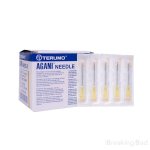- Language
- 🇨🇿
- Joined
- May 6, 2024
- Messages
- 213
- Reaction score
- 153
- Points
- 43
Les faibles doses (<100 mg) sont notoirement difficiles à peser avec précision, à moins d'utiliser des balances de très haute précision. Par exemple, pour préparer la kétamine pour l'IM, il peut être préférable de préparer un lot de cinq injections en dissolvant 500 mg de K dans 5 ml de solution saline, au lieu de peser 100 mg pour une injection (qui pourrait être de 150 mg en raison d'une erreur de balance).
Considérons une solution stérile garantie préparée par cuisson de K dans une solution saline. La solution est ensuite aspirée dans des seringues stériles à l'aide d'aiguilles stériles neuves ou de filtres à seringue de 0,22 um. L'aiguille de chaque seringue est ensuite remplacée par une aiguille neuve. Pendant combien de temps peut-on conserver en toute sécurité une injection ainsi préparée, vraisemblablement dans le réfrigérateur à 4-5 °C ? L'aspect de la stabilité du K ne me préoccupe pas car des études n'ont montré aucune dégradation du K stocké dans des seringues. Je m'inquiète de la sécurité micro-bactérienne des seringues stockées après une semaine ou deux semaines au maximum. Pourraient-elles être utilisées en toute sécurité ?
Considérons une solution stérile garantie préparée par cuisson de K dans une solution saline. La solution est ensuite aspirée dans des seringues stériles à l'aide d'aiguilles stériles neuves ou de filtres à seringue de 0,22 um. L'aiguille de chaque seringue est ensuite remplacée par une aiguille neuve. Pendant combien de temps peut-on conserver en toute sécurité une injection ainsi préparée, vraisemblablement dans le réfrigérateur à 4-5 °C ? L'aspect de la stabilité du K ne me préoccupe pas car des études n'ont montré aucune dégradation du K stocké dans des seringues. Je m'inquiète de la sécurité micro-bactérienne des seringues stockées après une semaine ou deux semaines au maximum. Pourraient-elles être utilisées en toute sécurité ?

